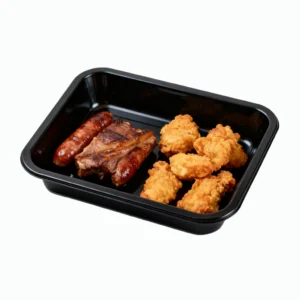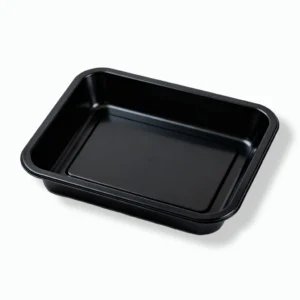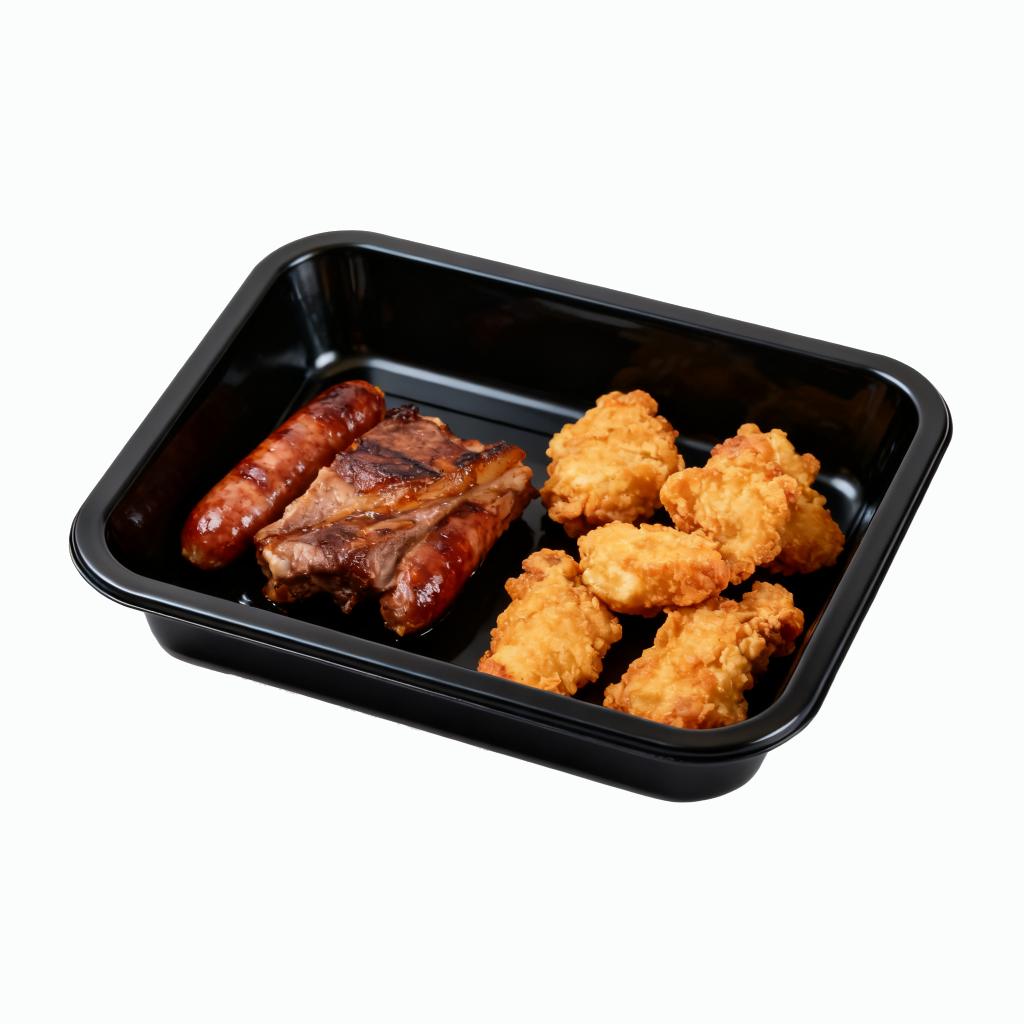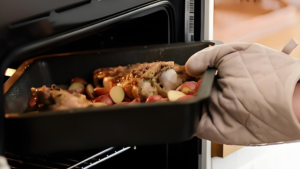Introduction

However, not all CPET trays are safe for food contact. FDA certification ensures the material meets strict safety standards, preventing harmful chemical migration into food—a critical issue that can lead to customer health problems, costly product recalls, and legal fines up to $250,000 per violation. According to intertek.com, improper food contact materials cause 30% of food safety incidents annually.
This guide provides a clear, actionable process to verify if your CPET takeaway tray suppliers truly comply with FDA standards. Whether you’re a restaurant owner or food packaging distributor, following these steps protects your business from compliance risks and ensures customer safety.
Basics of FDA Certification for CPET Takeaway Trays
What is FDA Certification for Food Contact Materials?
FDA certification for CPET trays isn’t a physical “certificate” you can hang on the wall. Instead, it means the material complies with FDA regulations for food contact substances. The FDA doesn’t issue approval certificates—suppliers must self-certify compliance by meeting specific technical requirements and providing evidence through testing.
Key FDA Regulation: 21 CFR 177.1520

- Material composition: No harmful additives like BPA, lead, or cadmium above safe limits
- Production standards: Hygienic manufacturing conditions meeting Good Manufacturing Practices (GMP)
- Migration testing: Maximum allowable levels of substances transferring from packaging to food (typically <0.05 mg/kg for most chemicals)
Why Fake “FDA Certification” Exists
Many suppliers display misleading labels like “FDA Approved” or “FDA Certified” without proper documentation. The FDA explicitly states it doesn’t “approve” food packaging materials—it regulates them. sgs.com reports that 45% of imported food contact materials fail compliance checks due to fraudulent claims. Always verify with official documents, not marketing materials.
Step-by-Step Guide to Verify FDA Certification
Follow these five concrete steps to confirm your CPET tray supplier meets FDA requirements:
Step 1: Ask Suppliers for FDA Compliance Documents
What to request:
- FDA Master File (DMF) number (also called Food Contact Substance Notification or FCN number)
- Certificate of Compliance (CoC) specific to CPET takeaway trays
- Migration test reports from FDA-recognized laboratories showing compliance with 21 CFR 177.1520
- Heavy metals test results (lead <0.5 ppm, cadmium <0.1 ppm per FDA limits)
Critical tip: Reject vague statements like “we are FDA-approved” or “FDA registered facility.” Demand written documents with specific regulation numbers. A legitimate supplier will provide these within 24-48 hours.
Example email template:
“Please provide: (1) Your FDA Master File number for CPET trays, (2) Certificate of Compliance referencing 21 CFR 177.1520, (3) Migration test reports from the past 12 months. We require these for our compliance audit.”
Step 2: Check FDA Master File (DMF) on the FDA Website
How to verify online:
-
Visit the FDA’s Food Contact Substance Notifications database:
https://www.fda.gov/food/packaging-food-contact-substances-fcs/food-contact-substance-fcs-notifications -
Search by FCN number or supplier name in the “Effective Notifications” list
-
Verify details:
- Product type must include “polyethylene terephthalate” or “CPET”
- Status shows “Effective” (not “Withdrawn” or “Under Review”)
- Manufacturer name matches your supplier
Red flag: If the supplier claims an FCN number but you can’t find it on the FDA database, the certification is likely fraudulent. Cross-check the manufacturer name exactly as it appears on invoices.
Step 3: Validate the Certificate of Compliance (CoC)
Essential information on legitimate CoCs:
- Supplier’s full legal name (not just brand name)
- Product specification: “CPET takeaway trays” (not generic “plastic containers”)
- Regulation reference: Must cite “21 CFR 177.1520” or “21 CFR 177.1630”
- Test report number linking to actual lab results
- Issue date (should be within 12-24 months—older reports may be outdated)
- Lab name: Must be FDA-recognized (SGS, Intertek, Bureau Veritas, TÜV SÜD)
Cross-verification step:
Contact the testing lab directly via their official website. According to intertek.com, you can verify report authenticity by calling their client services with the report number. Legitimate labs like sgs.com offer free verification within 1-2 business days.
Example verification call script:
“I received a test report numbered [XXXX-2024] for CPET trays from [Supplier Name]. Can you confirm this report was issued by your lab and is currently valid?”
Step 4: Request Sample Testing (Recommended for Large Orders)
For bulk purchases (>50,000 units), invest in independent testing:
Process:
-
Order sample trays from the supplier (request 5-10 units)
-
Send to FDA-recognized lab like:
-
Specify tests required:
- Overall migration testing (FDA 21 CFR 177.1520 compliance)
- Heavy metals screening (lead, cadmium, mercury)
- BPA/phthalates detection
- Heat resistance validation (220°C for 2 hours)
Cost: $300-$800 per test suite
Turnaround: 5-10 business days
Value: Avoids purchasing 100,000 non-compliant trays that could result in $500,000+ in recall costs
Step 5: Check Supplier’s Past Compliance Records
FDA enforcement database search:
-
Visit FDA Recalls, Market Withdrawals & Safety Alerts:
https://www.fda.gov/safety/recalls-market-withdrawals-safety-alerts -
Enter the supplier’s company name in the search bar
-
Look for:
- Food contact material violations
- Import refusals (FDA Form 483 citations)
- Warning letters about contamination
Additional check: Search the FDA Import Refusal Reports:
https://www.accessdata.fda.gov/scripts/importrefusals/
If the supplier has multiple refusals for “food contact material violations” in the past 2 years, this signals systemic quality issues. Choose a different supplier.
Common Mistakes to Avoid When Verifying FDA Certification
 1: Confusing “FDA Registered” with “FDA Compliant”
1: Confusing “FDA Registered” with “FDA Compliant”
The difference:
- FDA Registered = The supplier’s facility is listed in the FDA database (mandatory for all food-related businesses exporting to the U.S.)
- FDA Compliant = The specific CPET tray product meets 21 CFR 177.1520 technical requirements
Why it matters: A supplier can be FDA-registered but still sell non-compliant products. Always verify product-specific compliance, not just facility registration.
2: Accepting a “General FDA Certificate” Not Specific to CPET Trays
Some suppliers provide certificates for “plastic food containers” without specifying CPET material. Risk: The certificate may cover different polymers (e.g., polypropylene) that don’t apply to your CPET trays.
Solution: Demand certificates that explicitly state “CPET” or “crystalline polyethylene terephthalate” and reference the exact tray model you’re purchasing.
3: Believing Verbal Promises Instead of Written Documents
Common scenario: Supplier says, “Yes, we’re FDA-approved, don’t worry!”
The problem: Verbal assurances are legally meaningless. In a lawsuit over food contamination, you’ll need written proof that you performed due diligence.
Action: Only accept official test reports, CoCs, and FCN numbers in writing. Save all email correspondence for compliance audits.
4: Ignoring the Expiration Date of Test Reports
FDA migration test reports typically remain valid for 12-24 months. After this period, material formulations or production processes may change, invalidating old results.
Red flag: A supplier provides a 2020 test report in 2025—the current product may differ significantly.
Best practice: Request reports dated within the past 12 months. If unavailable, ask why and consider independent testing.
5: Skipping Sample Testing for “Certified” Suppliers
Even reputable suppliers occasionally ship non-compliant batches due to production errors. Case study: In 2023, a U.S. catering company faced a $180,000 fine after serving meals in CPET trays that leached antimony above FDA limits—despite the supplier’s valid FCN.
Protection: Test random samples quarterly if you’re a high-volume buyer (>100,000 trays/month).
Tools & Resources for Easy Verification
FDA Official Links (Bookmark These)
-
Food Contact Substance Notifications Database:
https://www.fda.gov/food/packaging-food-contact-substances-fcs/food-contact-substance-fcs-notifications -
FDA Recalls & Safety Alerts:
https://www.fda.gov/safety/recalls-market-withdrawals-safety-alerts -
FDA Import Refusal Reports:
https://www.accessdata.fda.gov/scripts/importrefusals/ -
21 CFR 177.1520 Full Text:
https://www.ecfr.gov/current/title-21/chapter-I/subchapter-B/part-177
FDA-Recognized Testing Laboratories
- SGS: sgs.com – Offers Food Contact Product Certification Mark
- Intertek: intertek.com – Food packaging analysis services
- Bureau Veritas: Compliance testing for 21 CFR regulations
- TÜV SÜD: European and FDA dual certification testing
Pro tip: Save these links in a “Compliance Verification” browser folder for instant access when evaluating new suppliers.


 1: Confusing “FDA Registered” with “FDA Compliant”
1: Confusing “FDA Registered” with “FDA Compliant”